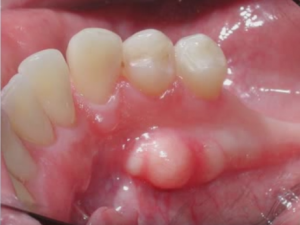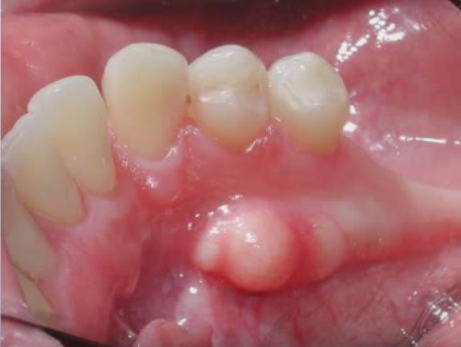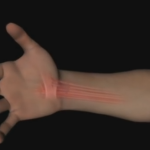Torus mandibularis refers to a nodular and bony growth that occurs on the inner surface of the lower jaw and typically attached to the jaw. When such bony growth occurs on the palate or roof of mouth, then it is called patatinus.
Torus mandibularis typically occurs in pairs and its size can vary significantly. It may be just a tiny bump, or sometimes it can grow so large as to touch one another. The bump may be hard to feel and may be enclosed in normal gum tissue.
People with big growths tend to elicit distress and discomfort as well as difficulties in chewing and swallowing. Some patients may experience difficulties in properly fitting the dentures due to the growths. Others may suffer from ulcer formations due to extensive and long-term oral pain and infections caused by torus mandibularis. In rare cases, the growths may adversely affect the management of the airways.
Small growths are quite common, especially in males. They are benign and usually not serious. However, patients may need to seek medical attention if there is sudden change in the size, color, or texture of the growth or if severe symptoms or certain health complications arise due to torus mandibularis.
Doctors are not aware about the cause and reasons for the presence of torus mandibularis growths. It has been postulated that certain activities which stress the jaw, like bruxism or teeth grinding, can trigger it. Patients need to contact a dentist or a surgeon to check if there is any need of treatment.
Causes of torus mandibularis
The exact cause of torus mandibularis is not known. However, there are many factors which may trigger such growths.
- The bony growths has genetic origins and passes on with an autosomal dominant pattern. It is more prevalent in Inuits, Koreans, and other Asians.
- The condition is more common in men and the average age of onset is between 40 and 50 years. In adults, the incidence rate of torus mandibularis lies between 12.2 percent and 27 percent, while it is very rare and low in children at just 3 percent.
- It is also though that teeth grinding can trigger the formation of such bony growths. Masticatory stress and teeth grinding tend to add to the occolusal load, especially in individuals who eat a coarse and granular diet. The consequent increased pressure and force on the periodontal ligament can then activate the formation of the new bone on the inner surface of the lower jaw near the premolar region.
- The bony growths may also appear after a prolonged period of elevated stress levels.
- Torus mandibularis may sometimes occur along with underling conditions like abscess formation, bone cancer, salivary gland tumors, vascular tumors, and fibromas.
- Removal of the growths does not necessarily prevent them from growing once again. Thus, their reoccurrence is an indication that it can be part of the continuous process of bone formation in the oral cavity instead of being a onetime defect.
Torus mandibularis and dental problems
Torus mandibularis may not cause medical issues which may warrant a treatment. However, it can cause a variety of dental problems, some of which are mentioned below:
- The growths may hamper the working of other dental procedures like dentures. If a patients has to be fitted with lower or upper dentures or flippers, then removal of the bony tori may be necessary. But as there is a possibility of them growing again, they may need to removed, again later.
- Torus mandibularis may sometimes facilitate occurrence of anomalies in the mouth, such as accumulation of plaque, which can then cause many dental problems. The presence of periodontal pockets can only be effectively treated after the successful removal of the abnormal bony growths. Doing so can help promote better dental care, better angles for efficient brushing, and better oral hygiene.
- The additional bone in the oral cavity may have to be removed so as to reduce the stress that food may exert on it, thereby enhancing dental health.
- Other complications include oral pain, increased risk of infections, and airway management problems.

Treatment
Treatment of torus mandibularis is usually not needed. It may however be surgically removed in the following scenarios:
- It is possible to shape the dentures in such a way that it accommodates the bony growths, thereby avoiding the need to remove them. However, if the growths are big, or if its size, shape, texture, tends to vary continuously, then they need to be surgically removed. Only then the dentures can be fitted in.
- Torus mandibularis may need to be removed if it poses problems in effective brushing, maintaining oral hygiene, hampers the airways, facilitates occurrence of infections or other dental diseases, or causes severe oral pain.
Reoccurrence of torus mandibularis after its surgical removal is rare. When they do grow again, it does so at a very slow pace and may take many months and years to grow back to its original size. Patients however need to go for regular checkups to verify if the growths are reoccurring after surgery.



IS THIS JAW MALFORMATION CAUSED FROM LONG TERM EVOLUTION OF LARGER JAW FRAME,(NEEDED IN CAVEMAN DAYS),DECREASING TO OUR NOW SMALLER JAW FRAME? IS THIS “EXTRA” BONE MASS TRYING TO FIT INTO OUR MOUTH, AND NOW NO ROOM SO CAUSES THESE BUMPS? I FIND DICOVERIES OF TOO MANY TEETH IN OUR NOW SMALLER MOUTH BUT NO PROOF THAT TORUS MANDIBULARIS’S IS THE SAME CAUSE.